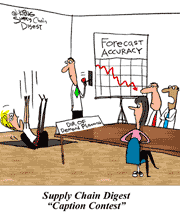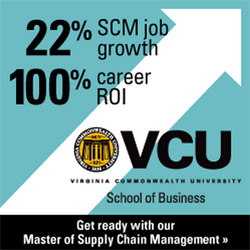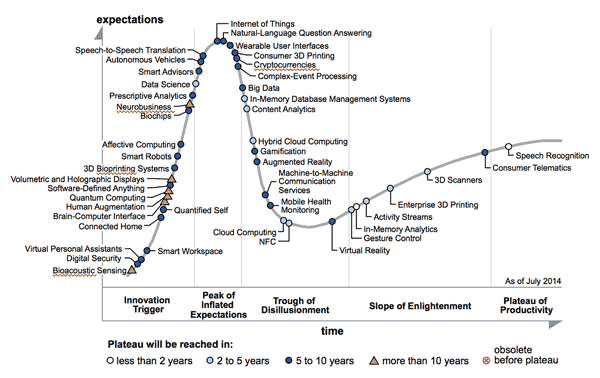 |
March 12, 2015 - Supply Chain Flagship Newsletter |
 |
| FEATURED SPONSOR: VCU |
||
 |
||
|
||
 |
|
||||||||||||||||||||||||||||||||||||||||||||||||||||||||||||||||||||||||||||||||||||||
It was an interesting dynamic. Not only was Apple facing external scrutiny and criticism, including some major negative articles in the New York Times, but CEO Tim Cook said many employees were worried that maybe Apple wasn't really a "good company" amidst the allegations. Perhaps they would run off to Facebook. So Apple began upping its level of supplier audits dramatically, from 127 in 2010 to 188 in 2011 to an amazing 633 last year. And those audits grew to encompass not just direct suppliers but its extended supply chain, meaning you can be a second or third tier supplier and have Apple's inspection gang scheduling your procedure. While most audits are scheduled, in recent years Apple has started to conduct "surprise audits," where it shows up at a supplier and expects to be let in to do its audit business within 2-3 hours. I don't know how far back in the supply chain Apple goes with the surprise audit version, but in theory you could be a chip maker selling to a board manufacturer selling to a contract manufacturing building products for Apple, and be subject to a surprise audit at one of your factories. Is this all a good thing? I am pondering. In 2009 of course Walmart started its Supplier Sustainability Index, which somehow rates its vendors on a series of environmental and other areas to produce a score that is some indication of how Walmart views its suppliers' practices. The elements of the score come from work Walmart did with an outfit called The Sustainability Consortium (TSC). TSC is jointly run by the University of Arkansas and Arizona State University, and has evolved into a collaboration of more than 100 of the world's largest retailers, consumer product companies, and NGO and academic partners. Is the score a company receives on the Sustainability Index correct? I would assume largely so, but is it always fair? I don't know. Increasingly a vendor's score - and thus perhaps its very survival - is a factor in whether Walmart will buy from that supplier. At the same time, Walmart merchandisers are increasingly evaluated personally on how well they are using the index to make vendor-product sourcing decisions. What a major change. A couple of weeks ago, Walmart launched a consumer-facing side to this program, where on its ecommerce site (and perhaps soon in stores) Walmart will tag certain products as "Sustainability Leaders." Will that designation affect consumer behavior? That is the trillion question, and we will all be interested in the results. If the impact is significant, especially if the program moves in-store too, then it will inevitably force all vendors to meet the standard for the designation (a score of 80 or more out of 100 in a given product category's measurement criteria). Ironically, when all vendors are meeting the standard, then the designation becomes meaningless.
Consumer products giant Procter & Gamble is among a number of very large companies requiring its suppliers to report their own CO2 emissions. Another one that interested me was news out of Ford in 2013 that it was pushing suppliers hard to get on board with its sustainability goals, using a tool it created in 2005 that it calls the Aligned Business Framework (ABF). Under the program, Ford signs bilateral agreements with suppliers that "comprehensively and formally spell out specific business commitments," based on 20 key principles that address specific Ford commitments, supplier commitments, and bilateral commitments. In other words, it would seems Ford sort of owns you (admittedly not knowing a whole lot about the details of this program). There is some carrot with the stick for being part of the ABF program, with Ford willing to extend longer term commitments to suppliers that are part the program. But one requirement is that suppliers must take control of their own supply chains - thus Ford's ABF suppliers must manage and assure proper working conditions, ethical treatment of workers, and responsible environmental management systems in their own operations and extended supply chains. In other words, the suppliers must do the work for Ford in meeting Ford's goals and policies in their own multi-tier supply chain networks. Finally, whether you love it or you don't, the UK's Carbon Disclosure project used a sort of sneaky if effective tool to get large companies to participate in its services years ago by convincing a large number of banks and financial firms - the types that can affect a company's stock price - to indirectly apply pressure on product firms to get with the CDP program. Those companies in turn now "encourage" their own suppliers to complete the CO2 emissions reporting, which some 3400 did in 2014. There are many other examples. So, what's the point? As noted at the top, I just wonder whether there should be any limits to how far this can go. Of course, at one level I recognize that a company should be able to source materials and products from whatever companies it wants, and if it decides to attach a growing list of conditions largely related to social good beyond product and price than that is its decision. Hard at one level to argue with that. Still, there is a libertarian streak in me (applied now to business) that wonders if a company that Apple doesn't even do direct business with should be subject to an instant audit if the inspectors knock on its door some morning. Or if a large company should be able to say I won't do business with you if you aren't using all Smartway carriers. Put yourself in the seat of the smaller or mid-sized vendor (the P&Gs can deal with all of this just fine) that must now jump through a whole lot of perhaps expensive hoops it never encountered before. If just the large companies can quickly be designated Sustainability Leaders, for example, is that a good result? And part of the reason for my concern is that this dynamic is only possible because some companies - Walmart, Apple, others - have become so large and profitable they can effectively exert the pressure - and afford all these audits. So, if Sam's Club ever gets spun out as a separate company, it may still be interested in Green, but even at about $58 billion in sales its ability to apply the pressure on suppliers and devote the resources to do so would be a lot less than the full Walmart today. All that said, I am reminded that when Nike first tried to fend off allegations in the 1990s of "sweat shops" and more by basically saying "we don't own or control those suppliers," that stance didn't exactly win the day. Nike was forced to take much more direct control of its outsourced supply chain. So I would say in the end it is what it is, and it not only isn't going to change, the control from the "supply chain masters" is likely to grow even more heavy. And it is mostly good in terms of results. No doubt working conditions at Apple's direct and indirect suppliers are better today for maybe tens of thousands of workers because of Apple's audits and related programs. But I don't think it is all good - though I am probably in a minority. If you are a large company today, you are - and increasingly "own" - your extended supply chain. There is a huge change going on here. Never seen anyone else touch this topic - be interested in what you have to say (anonymity requests respected as always). Should there be any limits on how much large companies can control vendors in their extended supply chains? Or is it all for the good? Let us know your thoughts at the Feedback button or section below. |
|||||||||||||||||||||||||||||||||||||||||||||||||||||||||||||||||||||||||||||||||||||||
|
|||||||||||||||||||||||||||||||||||||||||||||||||||||||||||||||||||||||||||||||||||||||
|
|||||||||||||||||||||||||||||||||||||||||||||||||||||||||||||||||||||||||||||||||||||||
|
|
|
YOUR FEEDBACK
We publish here a couple of more emails from our rent column on "Supply Chain Predictions 2015 from the Analyst Community, some of which we publish below.
Feedback on Supply Chain Predictions 2015 from the Analyst Community:
The column reminded me of an article published in The Economist late last year titled "Devining Reality from Hype". The article shows a "hype" cycle and the source is Gartner. See image below:
As for 50% of current supply chain execs being gone by 2018, I highly doubt it. They may not be with the same organizations, but there is too much demand AND good talent out there that I'm sure they will be with us. David Armstrong Inventory Curve, LLC Editors Note: I think moving to new organizations would count as being "gone" in Gartner's calculus. I agree demand is such that most will land somewhere if they leave their current organizations, but the Gartner thesis is there will be a disconnect for many (50%) between CEO expectations and what the supply chain exec can deliver. We'll see. Dan Gilmore
|
||
| More on Supply Chain Predictions 2015 from the Analyst Community: | ||
I appreciate your summarizing some of the predictions of the analysts like that. It is very interesting to see them. I am not sure that I agree with Simon Ellis that we will see a move towards what he calls "micro logistics," or many smaller, more local distribution centers versus fewer, larger ones. This trend has actually be predicted for many years, and never seems to happen. The operational efficiencies of the larger DCs combined with the inventory advantages of fewer facilities (fewer DCs that require safety stock) instead favor fewer larger DCs, a trend I think will be accelerated by the growing opportunities to use advanced DC automation. The ROI behind that automation works in a large DC, but not in smaller ones.
Scott Beloitt
|
SUPPLY CHAIN TRIVIA ANSWER
Q: What percent of furniture sold in the US is now American made?
A: About 21.5% in 2014, according to the Wall Street Journal. That's down from about 50% in 2005 and 78% in 1995
| © SupplyChainDigest™ 2003-2015. All Rights Reserved. SupplyChainDigest PO Box 714 Springboro, Ohio 45066 |
POWERED BY: XDIMENSION
|






 In early 2014, Walmart notified its suppliers they would have to reformulate soaps, makeup and household cleaners as it moved to shed what it said were harmful chemicals from store shelves. Walmart was there to help re-engineer.
In early 2014, Walmart notified its suppliers they would have to reformulate soaps, makeup and household cleaners as it moved to shed what it said were harmful chemicals from store shelves. Walmart was there to help re-engineer.


